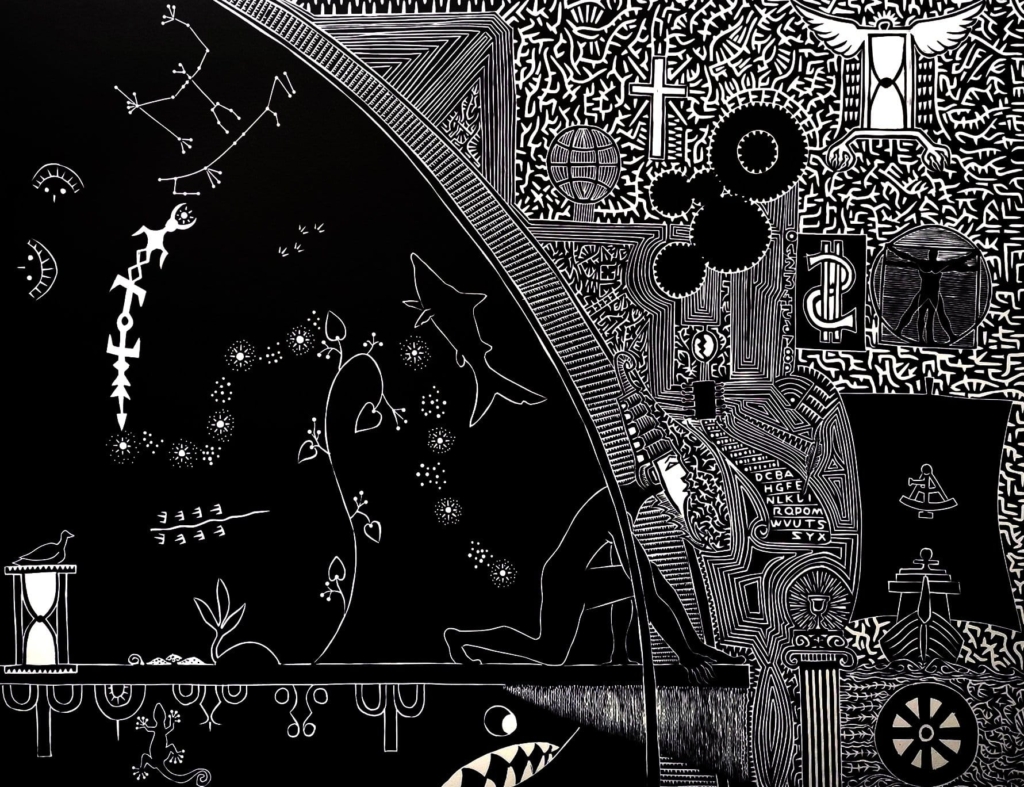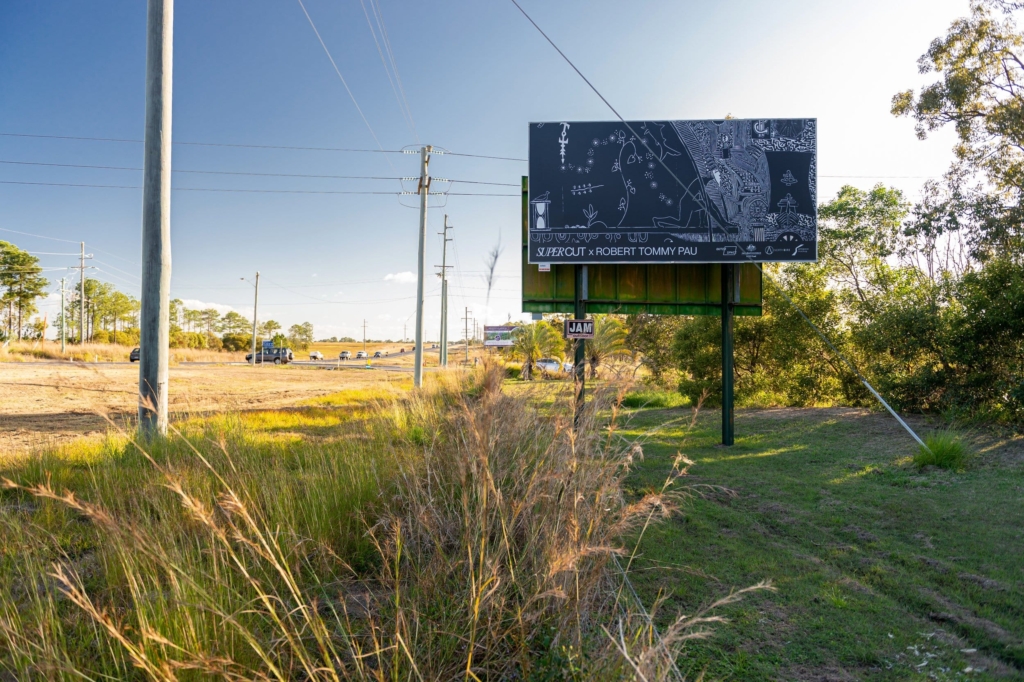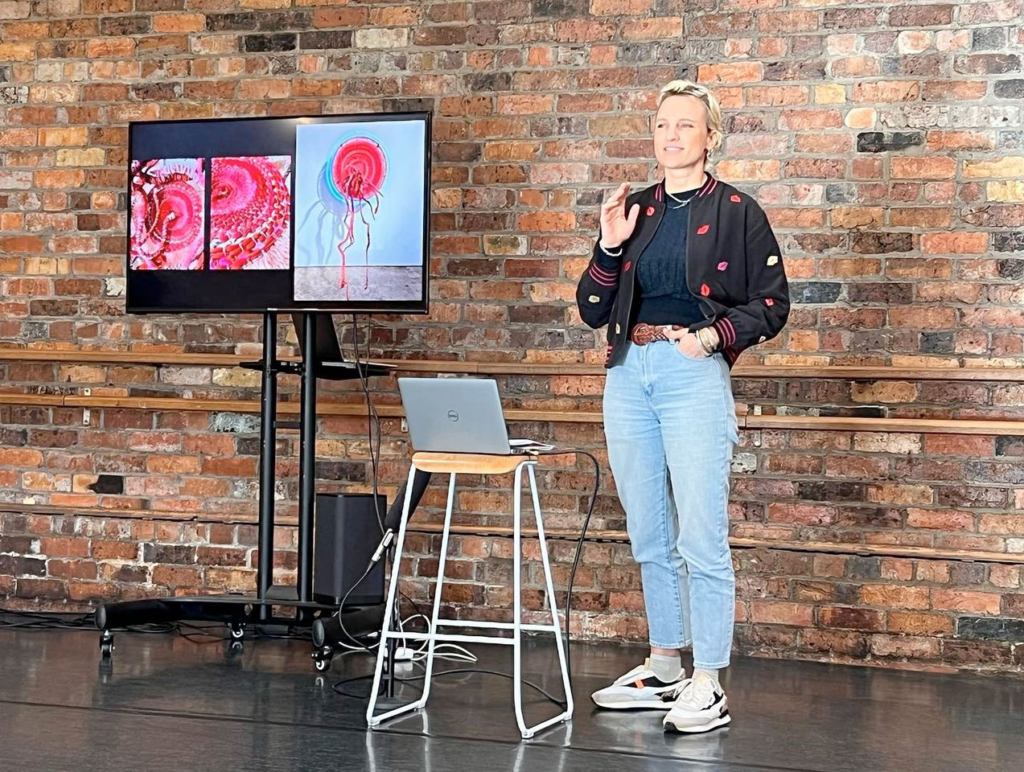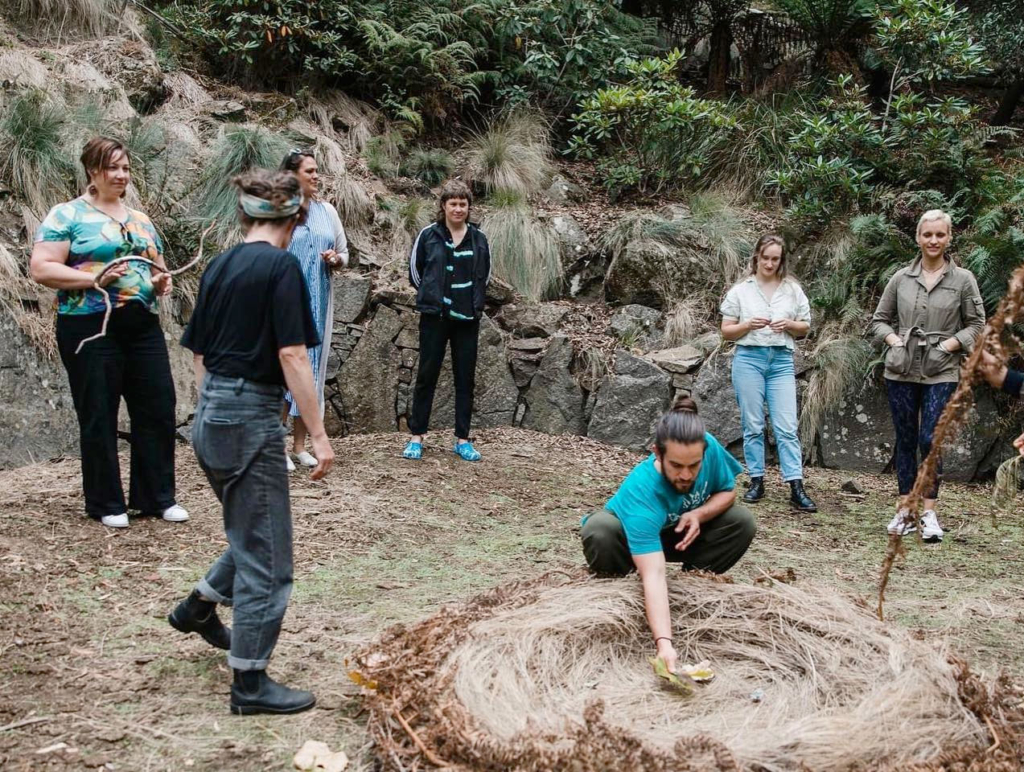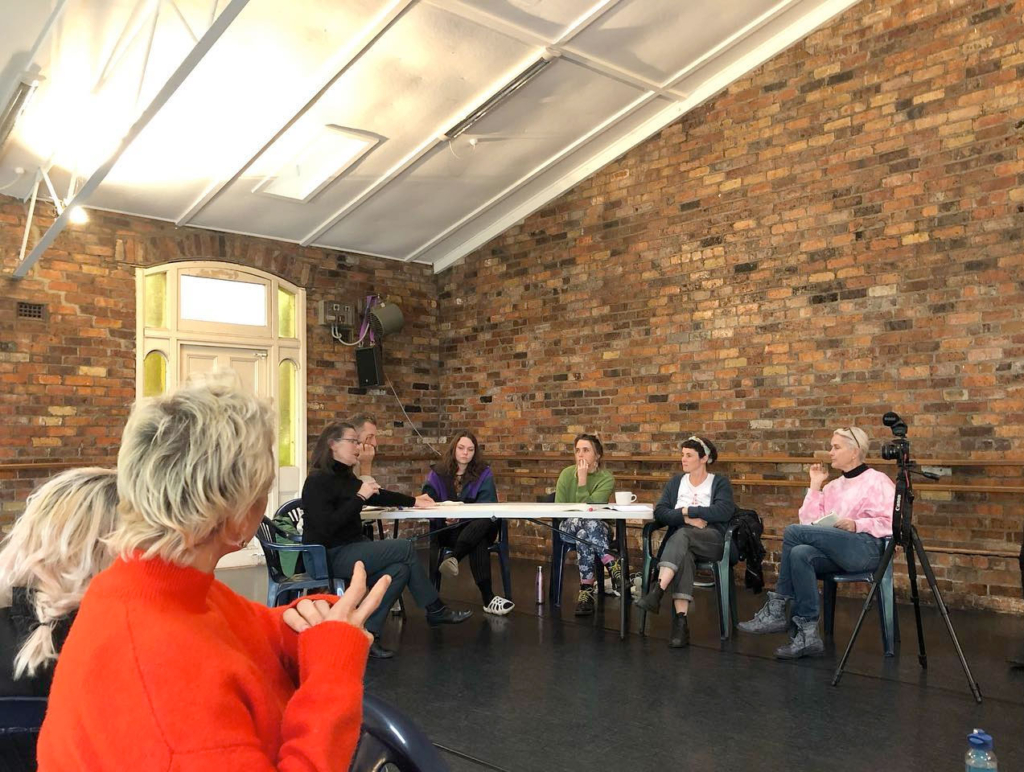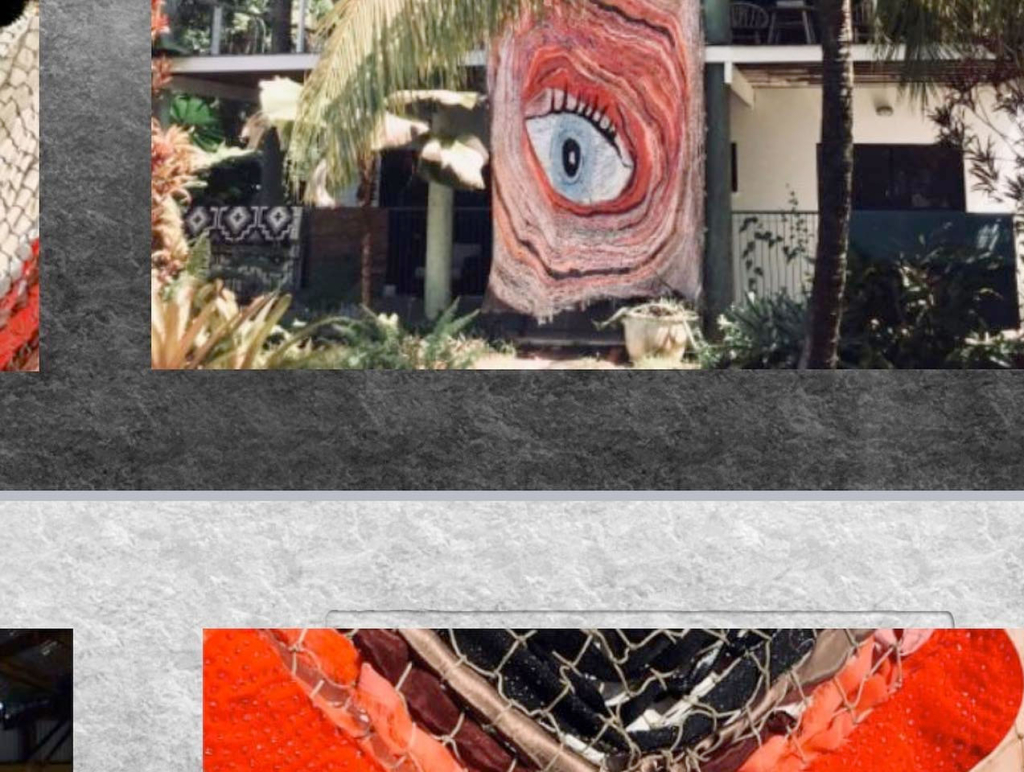This International Women’s Day we’re celebrating three women who are showcasing their incredible work in the NorthSite Gallery at Bulmba-ja: India Collins (Artist), Regi Cherini (Artist) and Tess Maunder (NorthSite Guest Curator).
India Collins is a Cairns-based artist specialising in woven sculptural forms and digital technology. She is also the Exhibition Manager for Cairns Indigenous Art Fair (CIAF) and is currently part of the SITUATE Art in Festival programme. India has greatly contributed to the Far North Queensland arts community and is showcasing her exhibition in ‘e VULVA lution’ at NorthSite. You can get involved in her exhibition by sharing a personal story or contributing an item of pre-loved clothing. Visit www.northsite.org.au/e-vulva-lution/ for more information.
Regi Cherini is another Cairns-based artist who has embraced regional and remote northern Australia. Through her art practice, Regi is interested in challenging and undermining notions of imposed boundaries and hierarchies of creativity, raising embroidery out of the realm of craft and into that of fine art. Her exhibition Sweet Nostalgia is showing in the NorthSite gallery at Bulmba-ja until 11 March 2023.
Tess Maunder is a curator, writer and editor based in Melbourne. She has a decade of experience working in the cultural sector focusing on programming contemporary visual art practice. Tess has curated the exhibition ‘Planetary Gestures’ bringing together a range of artists who think deeply about alternative geographies. The exhibition was devised to explore ideas surrounding ecological systems, ancient knowledge, celestial blueprints and tidal movements across the land, sea and sky known as Australasia, part of the wider Asia-Pacific and the ‘Great Ocean’. Planetary Gestures is showing in the NorthSite gallery until 15 April 2023.
Happy IWD!
Public Art From Gab Titui Cultural Centre
Vibrant marine life stories of Zenadh Kes (Torres Strait Islands) abound through the Gab Titui Cultural Centre offering on the Bulmba-ja art centre digital façade.
Featuring artworks from Moana Ahwang, George Gabey, Laura De Jersey, and Jimmy K Thaiday, seafaring scenes portray crayfish freediving in bommies and dugong feeding trails in the shallows, with Spanish mackerel game fish, mating turtles, and birds in flight.
The shape of dugongs in the dhari (headdress) symbolically align with the swimming shark illustrating cultural connection. Depicting ancestorial totems and patterning through painting and linocut techniques relates deep knowledge and listening to the endemic wildlife that traverses and calls the region home.
Come and experience these artworks on the Bulmba-ja LED facade: 96 Abbott Street, Cairns City 4870
Commissioned by NorthSite Contemporary Arts through the Bulmba-ja Digital Artwork Commissioning Program for Arts Queensland.

Artwork on Bulmba-ja Facade, 2022, digital animation, LED strips on building. Courtesy of Gab Titui Cultural Centre and NorthSite Contemporary Arts.
On ‘Pressing Topics’
A multi-media installation of projection, sculpture, digital collage, video and sound to critically examine the unseen labour of women.
Written by Melania Jack of The Ironing Maidens
The Ironing Maidens project is the art love child of Patty Preece and myself, Melania Jack. Over many years of shifting industry paradigms, from live shows to live streams and back, the project has seen many incarnations. During lockdown our inbox filled with cancellations of the live show into which we had just invested a year of work., So we adapted to the strange times by experimenting with media new to us, including a pilot episode of a narrative-based podcast, a live stream project, and most recently installation work. Some of these projects were a great experience, helping us to acquire new skills and experience new collaborations; others were like random op shop finds: we took them home, and they just didn’t quite fit.
We slowly realised that the previous show, A Soap Opera, would not tour again. It would be too long until venues reopened; and more personally, we had outgrown this work. Our political views on these subjects had changed too much. The world also felt different, more serious. How can we pun about ironing while people are dying from covid? How can we broach these domestic issues when people have had no choice but to be contained to the domestic home? It’s like calling a caged bird lazy. Still, it felt like there was so much left to say. While families isolated, more people spending more time at home meant more work for women. Sourdough bread and home improvements became just another expectation for women to add to their massive daily list of to do’s.
Statistically, and anecdotally, the housework situation hasn’t changed much for women since the 1950s. The stats show that from cleaning the home to cleaning up the environment, it’s still women doing the bulk of the work – physically and emotionally. On top of that we are not getting paid for it. The Workplace Gender Equality Agency, in a report released on the 12th December 2022, show that women earned, on average, $26,596 less than men in 2021-22.
We’ve spent generations teaching girls that they can ‘do anything’: more women as CEOs, more women learning to code, more women in tech; but when women in Australia are spending the equivalent of one whole month of housework each year more than their partners – how do they find time to further their careers and invest in themselves? How do we reinvigorate the stalled feminist revolution of the ‘70s that was meant to free women from the role of ‘domestic goddess’ when social media is bursting with cleaning influencers like Mrs Hinch, who are glamourising and cashing in on the collective social anxiety of the (COVID) moment?
With a lack of real solutions to the gender imbalance in the domestic debate, the common response is to send the work further down an even more feminised and also racialised line – hire a cleaner, send the clothes to the dry cleaner, pay for help, and in the spirit of the 4 hour work week – outsource, outsource, outsource. This excess work is increasingly the lot of low-paid, migrant and women of colour who are then experiencing rising rates of exploitation and abuse.
Feminists can call out for women to march, smash the patriarchy, pull down the capitalist structures, decolonise the country – but how do we start any of that while standing at a kitchen sink full of the greasy slippery dishes of romantic promise, family expectations and the ground-in grime of gender socialisation?
This is what I am exploring in Pressing Topics, a sound and projection installation that is presenting at NorthSite Contemporary Arts from December 2022.
In Strike, a projection and sculpture piece, I use the lens of glitch feminism (a term coined by Legacy Russell) to explore ironing itself – utilising a 1950s image of the quintessential housewife ironing. This is the image that second wave feminists rallied against – a white, middle class housewife doing all the housework among the avalanche of white goods designed to lure her back into the post war household. But there is a glitch, an error; the image breaks and reveals what is underneath: the women working in the factories to sew and iron those clothes she irons, the women in the factories building the iron and its components. Women are employed for their patience, attention to detail and ‘nimble fingers’. This trend that has moved from the fashion industry to the IT and new tech sector is seeing millions of women existing in modern day slavery conditions. Their slavery builds irons, for other slaves to iron. The irony is real.
In Domestic Body, I explore my own gender training within my family and society as an eldest girl child. The need to please, the guilt of not doing enough, the idea that satisfaction should come from a clean kitchen floor. The patronising pink used in this work is overt and constant, bleeding into the skin while the forced smile gleams. The body has become part of the machine: washing machine belly, iron hands – I am the tool and the work itself. Again, the glitch disrupts, exposing other emotions – fear, sadness, regret, loss, mania, anger. How is my self imagined in this domestic body?
I am sometimes asked: why do I care? As a queer, non-binary person who is trying to build a different life to the one I was raised in, I can choose to sit and read a book and let the dishes wait. But can I? I still feel the pressure to do the dishes first. Since taking on the co-care of an elder with dementia, I feel keenly the sense of duty to provide this care. As a woman. It seems cellular, but it is sold as feminine and nurturing – I know it is socialised. Children and elder care are a massive global themes. It is the work of women and like all feminised industries, it is underpaid and unacknowledged.
This gender imbalance seems to run all the way into our futures. Technology will not save us; it didn’t save the women of the 1950s, who just ended up with more work at home, managing the new machines. Now the smart homes of the future require new attention – to program the smart fridge, to talk to the assistant who will turn the lights on. Studies such as those in the recent book, ‘The Smart Wife’ by Jenny Kennedy and Yolande Strengers, show that in this ‘smart future’ the work is still feminised; from the voices of the assistants, to the design of modern robots, we are building this sexism into our future.
They (seem to) burn with a strange fury, a comment by a critic of the original Wages for Housework activists of the 1970s, is the title of one of the pieces of this exhibition. In it I have used an algorithm to explore the extent of our gendered programing around domestic labour. I use the words ‘cleaner’ and ‘housework’ to search online video and image. The top image results from these search terms are generally women. I project these images onto ironing boards that stand around a burning fire of irons. Are they planning a revolution? Are they burning the tools that oppress them? Are they the ghosts of the past or are they people from our future?
These strange years have birthed this new work, a deeper exploration of the themes of The Ironing Maidens project.
My hope with this exhibition is that I can navigate a path out of my own gender training, to check myself and my privilege. To find ways to revive that stalled domestic revolution, with a more expanded and inclusive view. Because really, I am tired of the housework. I am busting to get onto the next work, a new world, the next question – what does a non-binary, de-capitalised, de-colonialised world look and sound like?
I don’t know yet, but I have some ideas; I imagine you might too.
Words by Melania Jack
The Ironing Maidens
2022
The Regional Arts Development Fund is a partnership between the Queensland Government and Cairns Regional Council to support local arts and culture in regional Queensland.
Upcoming exhibition insights
Andrea Huelin takes us inside the studios of the collective group Sixfold Project to delve into their upcoming exhibition, Meanwhile, showing at NorthSite from 18 November 2022 to 28 January 2023.
Ask an artist why they choose to work alongside others – even if they don’t really see them much, collaborate or socialise with them – and they may talk about a number of practical benefits. Important factors for many artists are the sense of shared endeavour, of community, of invisible moral support in what can be an emotionally fraught, physically challenging business involving sustained effort and will, often with unpredictable outcomes. The artists of Sixfold Project have devised a shared creative space like this, but it is not under the one roof. Indeed, it is not even in the same Australian state.
The six women met and began exhibiting together in Cairns, far north Queensland, but they are now working in their own studios, from various locations around Australia and New Zealand. Still, they benefit from this sense of working communally. Highly self-motivated, and prolific in their own careers, these mid-career artists don’t seek coaching, banter, or comparing notes as they negotiate their place in the art world – they already have the runs on the board. They are professionals who have seen the benefit in connecting with each other and sharing their journeys towards their collaboratively determined goal, purely because of the energy and reinforcement of purpose that is created by their common, simultaneous striving. As they have shown in the past, the power of their collective artistic sensibilities is powerful indeed.
The latest exhibition by the artists of Sixfold Project – Barbara Dover, Louisa Ennis-Thomas, Rose Rigley, Raewyn Biggs, Julie Poulsen and Jennifer Valmadre – is called ‘Meanwhile’, celebrating the power of the collective creative experience, while bringing their own philosophical and personal frameworks to the themes of time and place. New work for the exhibition has been created simultaneously by these artist colleagues, across disparate geographic locations.
The artists work in isolation but meet regularly via video connection to exchange thoughts and processes, and to seek candid responses; gradually refining and clarifying their intentions and experiments. The artists describe this process as an ‘energising’ opportunity to ‘reject, reshape, reaffirm and renavigate their works through a shared creative process’. Their work includes painting, sculpture, photography and installation, with a variety of experimental mixed media, as is the group’s usual multi-disciplinary approach. In each other, these individuals have recognised a similar work ethic, and a willingness to be fearless with their art making. Supported by each artist’s simultaneous efforts, they contemplate their experiences and preoccupations, and seek to express their evolution.
For some of the Sixfold Project artists, these contemplations are biographical. As she often does in her work, Julie Poulsen began with an idea expressed in words, in this case a poem reflecting on her experience of time. The resulting paintings and assemblage fragments are joyful jumbles of beaches and bodies, pets and play – perhaps a realisation that the act of collecting experiences through photographs, sketches and memories, and then giving them new life in her skilfully haphazard paintings is a beautiful way of experiencing life. Like so many memories or thoughts leading from one to another, her semi-abstract images seem to continue from panel to panel within the large diptych ‘Meanwhile the beach is warm’, with lines of stitching providing a visible manifestation of the intuitive process of resolving an artwork. Padded panels give a sensory dimension to the artworks, accentuating the assembled nature of the pieces.
Similarly, Rose Rigley began with a poem, written in the style of a fable, reflecting upon her family of origin. In her moving story about being a witness to the experience of victims of the Stolen Generation, Rigley contemplates ideas of connection, belonging, cruelty, kindness, strength and healing. The resulting sculptural pieces are organically shaped, tubular and transparent, crocheted from salvaged copper wire with what must have been no small degree of sustained physical exertion, determination and patience. As the artist says, ‘These disembodied tongues… (are) an ongoing mantra to hope and a helpless penance to the challenge of an unchangeable past.’ The installation has a gentle poignancy that characterises Rigley’s work.
For Raewyn Biggs, time and place were distorted by sudden illness in her family and international lockdowns, as she found herself a stranger in an unfamiliar expat community within a foreign city – Auckland, New Zealand. For ‘Meanwhile’, Biggs presents large-scale photographic projections that place her within, but clearly outside her new environment with its seemingly welcoming, colourful shopfronts. The artist portrays herself as a masked superhero figure, bravely landing in this new place that needs her, but she is unable to reveal her true identity.
Jennifer Valmadre’s mastery of her mediums is such that she can break the rules and let her ideas be guided and influenced by the materials themselves as she pushes them to uncharted places. Her trust in her process and her resulting track record of extraordinarily original work has led to this new series, ‘Bowls of colour’, multiples of wall-mounted, semi-spherical forms made from casting plaster with nylon and fibreglass. The gelato-coloured concave surfaces have the inlaid techniques of encaustic painting, which contrast with the dark, nut-like shell on the convex side. The product of a long process of experimentation in colour theory and aesthetic conventions, this installation is highly original and intriguing.
Louisa Ennis-Thomas continues to experiment with form, texture and challenging materials in ‘Parasite (Clinging to the belly of the world)’: her speculative investigation of themes of exploitation and adaption. The textile installation is made up of more than 50 human-sized forms, cut and sewn from discarded agricultural sacks and suspended from the ceiling in an upside-down ‘forest’. The open weave of the hessian brings to mind skin as well as bark, creating an unsettlingly sense that the forest might be natural, but it is clearly a human-made plantation of sorts, with the limp forms clinging to the ceiling in rows. The installation, which Ennis-Thomas describes as an exploration of ‘our human desire to control, cultivate and harvest resources…and the global impacts this relentless preoccupation sets in motion’, shows the curiosity and intellect that characterises her oeuvre.
¬
In a magnificent synergy of ideas, Barbara Dover’s new work ‘Reckoning’ continues her career-long focus on the perils facing our environment, particularly animals who are caught up in the effects of a warming planet. The sculptural installation is foreboding exemplified: it takes the form of traffic safety cones formed from concrete, with found animal hair encased within, and protruding in places as if the animal was trapped in the form. The contrast between the organic animal-derived materials and the brutal concrete delivers that sucker punch of heartfelt recognition that Dover does so well. Dark, pockmarked forms of bollards in the installation, ‘Sentinel’, bring to mind charred ruins, while porcelain safety lights in ‘Detour’ suggest warning and threat.
Accompanying their individual bodies of work are two installations made in collaboration by all six artists. ‘Meanwhile’ is a playful video showing footage from each of the artist’s lives and working processes, giving environmental context to the artworks on show, and illustrating that the artists are simultaneously living different lives in different regions, with the connecting thread of creative progress towards the exhibition.
The installation in the Void space at the NorthSite Gallery is a collection of multiple artworks and objects that represent the creative development processes in each artist’s studio. The installation is like stolen peeks through windows or curtain partitions into the artists’ private studio workplaces, where there is evidence of the artists’ trials and errors pinned to walls, laid out on the floor, or waiting for attention on easels. This is the scene of the artists’ battle with their materials, processes and their own ambitions (and shortcomings) for the body of work they are focused on.
The Sixfold Project artists have circumvented the challenges of many mid-career artists, as well as those of artists living in isolated regional areas, by creating their virtual co-working space. Within this space, the artists have permission – indeed, more like an imperative – to be ambitious and to aim for excellence within their own practices. Working together, they have the confidence to go down the dark and sometimes scary path of the unknown, and to wrestle with materials and processes that might bring their ideas to light. In doing so, they are lifting the standard of contemporary art in their own regions by modelling determination and hard work, quality and professionalism to their fellow artists, their art students and mentees, their collectors and their gallery networks. Most importantly, their highly resolved and thoughtful artwork is adding to the visual language archive of human (and animal) experience; bringing us new ways to understand our world and ourselves.
Words by Andrea Huelin
2022
The Regional Arts Development Fund is a partnership between the Queensland Government and Cairns Regional Council to support local arts and culture in regional Queensland.
Illuminate FNQ Indigenous Science Festival
NorthSite recently partnered to support an Art Science Talk event for the inaugural illuminate FNQ Indigenous Science Festival.
The exhibition, Yuk Wuy Min Nguntamp, by Keith Wikmunea and Heather Koowootha produced by NorthSite in collaboration with Wik and Kugu Art Centre was included in the Friday activities of the Illuminate program. Heather Koowootha provided an extremely insightful explanation of her paintings of plants and natural resources that embody deep Wik cultural knowledge.
If you are interested in hearing more about this exciting new festival that drew scientists from across the world to Cairns and celebrated local ancient knowledge systems, check out the link to their wrap-up video, produced by artist and volunteer illuminate FNQ Board Director Dr. Jenny Fraser.
For more information about illuminate FNQ Indigenous Science Festival visit: https://illuminatefnq.org/home/
In other news, Dr Jenny Fraser has recently been awarded the prestigious 2022 Australia Council Award for Emerging and Experimental Arts! Congratulations Jenny!
Dr Jenny Fraser – Australia Council Award for Emerging & Experimental Arts
SUPERCUT x Robert Tommy Pau
In July 2022, Robert Tommy Pau’s artwork, titled ‘Time‘, was presented on a billboard along the Bruce Highway as part of NorthSite’s partnership with Outer Space for the SUPERCUT program.
“NorthSite has been delighted to partner with Outer Space for SUPERCUT which has created new opportunities for regional artists to showcase their artwork to a wider audience”, said NorthSite’s Artistic Director/ CEO Ashleigh Campbell.
This artwork tells an important story in past and modern history for the Torres Strait Islanders, reflecting on two different points in time and showcasing the vast contrast between these timelines.
“1871 is a point in time where Islanders refers to Coming of the Light. This is a very profound statement as it is a demarcation between their past history and modern history.” said Robert Tommy Pau
Tommy is a descendant of the Eastern Torres Strait Islands, Australian Aboriginal, Papua New Guinea, Pacific Islander and Asia. He speaks Torres Strait Creole and Australian English. He was taught about the need to keep culture strong through cultural practice by his father. He has a strong commitment to keeping old traditions alive and believes that culture must remain true to the past and move with time to exist in the future. Tommy has considerable experience in the arts and his art forms of choice include printmaking, painting and sculpture.
Billboard location: Bruce Highway, 3.2km west of Bundaberg Airport on Isis Highway
Outbound, Bundaberg, Queensland.
For more information visit: https://www.outerspacebrisbane.org/program/supercut-robert-tommy-pau
SUPERCUT is supported by the Restart Investment to Sustain and Expand (RISE) Fund – an Australian Government Initiative and is presented in partnership with Artspace Mackay and NorthSite Contemporary Arts, Cairns.
2023 — 2024 Program Call Out
NorthSite is a leading contemporary art gallery working with over 300 artists each year to deliver exhibitions and programs to the Cairns region and beyond. In 2021 NorthSite delivered over 20 exhibitions and over 100 programs. The NorthSite team have extensive knowledge and connections within the arts industry to support artists achieve their goals wherever possible.
Applications for our 2023 — 2024 exhibitions and programs are now open. We welcome emerging and established artists to express their interest in our 2023 — 2024 program call-out.
Open: Monday, 8 August 2022
Deadline: Monday, 26 September 2022
Repatriate essay by Carol McGregor
“The constructed nature of history and of identification is arbitrary, not fixed, but open to new possibilities of meaning and identification.”1
Repatriate brings together four artists who met and study together at the Queensland College of Art’s (QCA) Contemporary Australian Indigenous Art (CAIA) program, Griffith University, Brisbane alongside collective members Dion Beasley and Cairns (Gimuy) based artist Bernard Singleton Jr.
The title of the exhibition is usually associated with the return of objects or people, back to where they came from. An expanded definition includes to restore: to restore origins, allegiance, or citizenship2—adapted here as the duty and social responsibility to restore foundations. Specifically in this exhibition, a call to restore Australia’s true foundational historical accounts and memories.
Curated together the artworks are simultaneously loud and deeply poetic, informing us in a clear voice how histories are recorded, often skewed, and owned. The artists generously give us understandings why there must be honest considerations and fluidity for growth to restore our nation’s genuine narrative.
Darren Blackman’s (Gureng Gureng, Gangulu Nations), body of work speaks to the notion that there are two versions of the colonisation of Australia. In this process, Blackman proclaims his clan’s sovereignty through questioning the integrity of Eurocentric narratives that cling to “settlement,” and the purpose of that single ideology.
Blackman’s research uncovers how former Federal Education and Youth Minister Alan Tudge in 2021 argued that the problem with the draft changes to the national history curriculum “it [the impact of colonisation] gave the impression nothing bad happened before 1788
and almost nothing good has happened since.” Tudge emphasised how the planned updates downplayed Australia’s Western heritage and how we need to recognise that “…our democracy is based on our Christian and western origin with a reference to the importance of the values of patriotism and freedom”. 3
Australia’s shared history is one true history and there is fundamental responsibility for truth telling and to right wrongs—including in our education system.
As we witness the successive failures of the 2007 Close the Gap campaign 14 years on, and an Aboriginal Deaths in Custody rate of 1 death every 14 days since the Royal Commission Inquiry released its findings in 1991, with resemblances of protest banners, Blackmans complex text puzzles directly address failings in the dominant Eurocentric narrative.
Blackman states “the agenda is clear, Imperialism rebranded became capitalism, the Commonwealth Government of Australia continues to oppress First Nations people to continue the wilful destruction of their homelands to access resources. As a nation matures, questions are asked, conversations have started, the oppressors are nervous and the oppressed empowered. The truth hurts.”
Kyra Mancktelow (Quandamooka with links to the Mardigan people of Cunnamulla) in Gubba Up Mancktelow explores early encounters between the First Fleet and First Nations people and where culture was systematically damaged by the introduction of colonial garments—particularly the cast-off government and military jackets gifted to Aboriginal men as a way of assimilation and to cover up blak skin. As Mancktelow states her Ancestors “were named savages by the nakedness of their skin.”
‘Gubba Man’ or ‘Gubbamen’ were originally mispronunciations of “government” and subsequently ‘Gubba’ referred to all white people. Today ‘Gubba Up’, loosely translates to ‘whiten up’ – a phrase used by First Nations peoples to describe the need to change your way of life to suit your environment. To gubba up is to whiten up; to whiten up is to cover up. Gubba up and lose your Aboriginal identity. 4
In research led practice Mancktelow references colonial paintings from 1810-20 where Aboriginal men were depicted in ill-fitting jackets and coats.5 Mancktelow carefully recreates these garments in tarleton cloth. Tarleton was chosen purposely as it is a material used in the print making industry to remove ink from the etching plate. Mancktelow uses tarleton as a metaphor for the attempt to rub away the identity of cultural ways and knowledges.
The garments are uniquely relief printed and these all most transparent forms, are strongly overprinted with traditional weapons. By placing cultural artefacts on the garments Mancktelow directly signifies the continuum of culture and the untold history of resistance to assimilate and to gubba up.
Mancktelow’s artistic response is to the misconception recorded in colonial archives that cultural ways did not survive ‘successful’ assimilation and that beliefs, values and cultural practices were displaced by the governing Western society.
In his studies Dylan Mooney (Yuwi, Torres Strait/South Sea Islander) considers his Ancestor’s Yuwi shields housed in national and international institutional collections. Mooney seeks out spending time with these artefacts and reflects on them being so far away from Country, from their makers and the makers families.
Returning to the studio and after creating life size lithograph prints of the shields, Mooney hand colours the images, unequivocally reconnecting himself with the objects.
As part of his research process Mooney often visits Yuwi Country around Mackay and the areas the shields were made. Subsequently Mooney has worked with Elders hand carving his own shields from similar trees—understanding the process and connection these artefacts have to their creators and the land it came from.
Mooney takes this understanding and draws from his photographs on the back of the prints, the landscape and Country—restoring in a defined way the shields to their origins.
Dylan Sarra (Taribelang/Gooreng Gooreng) has been investigating the Burral Burral (Burnett River) Petroglyphs, on his Ancestors Country close to Bundaberg. Burral Burral flows from the Great Dividing Range and was the lifeblood of the Taribelang people. In a unique artistic tradition, the petroglyphs or rock-engravings were situated on an isolated outcrop of the river’s sandstone with an area of 3348 square kilometres and were considered the largest Aboriginal rock-engraving site on the east coast of Queensland at the time.
Between 1971 and 1972 a selection of 92 stone blocks from Burral Burral containing Aboriginal engravings and weighing up to 5 tonnes, were cut out of their original and traditional site and distributed to multiple locations across Queensland.
This was carried out by the State Government under the provisions of the then Aboriginal Relics Preservation Act 1967. The site was subsequently flooded during a dam construction and the removed blocks are still scattered across Queensland.
In his studio-based-practice research Sarra creates his own petroglyphs to understand how the stone feels to carve—the effort and skill needed in a similar way his Ancestors carved the Burral Burral stones. Sarra plans to create 92 individual carvings to represent the shattering and displacement of his Ancestors petroglyphs.
Each of his carvings is then replicated as prints with detailed lithography processes.
Sarra’s final body of work explores the stories surrounding the stones and will ultimately include bringing all 92 prints together symbolically restoring the Burral Burral Petroglyphs and “lighting of the embers to continue the conversation of repatriation.” 6
The invitation to local Yirrganydji Traditional Owner, Bernard Singleton Jr to contribute and respond to the ideas contained within Repatriate provides a powerful presence and further contemplation.
“Cultural extraction is still happening. The taking away bits of history without providing any context for it. The dark pasts that are hidden or forgotten and the emotional consequences that are ongoing. This representation of extraction practices that signifies our old people were in unison with Country and solutions
were at hand.”7
Darren Blackman, Kyra Mancktelow, Dylan Mooney, Dylan Sarra, Bernard Singleton Jr and Dion Beasley are First Nations artists that deeply investigate Australia’s histories from a true perspective, and as knowledge holders offer visual form and skilled poetic ways of informing us. Their research and artworks are conduits for truth telling and as such how we move forward as a nation.
Essay by Carol McGregor
2022
1 Gordon Bennett, “The Manifest Toe” in Ian McLean & Gordon Bennett, The Art of Gordon Bennett, Craftsman House, Australia, p 42
2 https://www.merriam-webster.com/dictionary/repatriate
3 https://ministers.dese.gov.au/tudge/roaring-back-my-priorities-schools-tudents-return-classrooms
4 https://www.nsmithgallery.com/artists/53-kyra-mancktelow/works/
5 As they did not wear the jackets or garments ‘correctly’ Aboriginal people were often ridiculed such as in the 1819 watercolour ‘Sauvages de la Nouvelle Galles du Sud’ attributed to Alphonse Pellion.
6 Dylan Sarra 2022
7 Bernard Singleton Jr 2022
Ceramicist Kim Nolan is selected for Unleashed 2022
Congratulations to Kewarra Beach-based artist Kim Nolan who will be exhibiting work in Unleashed 2022 at Artisan, the home of Queensland Craft and Design, situated in Bowen Hills, Brisbane.
Unleashed is a longstanding biennial exhibition project, drawing together a select cohort of early-career Queensland craft and design practitioners and launching their careers. Exploring the convergence between craft and design, Unleashed has been instrumental in launching some of our state’s best talent.
Kim Nolan and 5 other leading craftspeople from Far North Queensland were nominated by Lauren Carter (Retail Manager, NorthSite Contemporary Arts) and Kim’s work was selected through a process with institutional partners from across Queensland.
The panel comprised of:
Ruth Della, Curator, HOTA (Home of The Arts)
Megan Williams manager, University of Southern Queensland Art Gallery
Cassandra Lehman, curator, artisan
Ashleigh Campbell, Director, NorthSite Contemporary Arts
Tracey Heathwood, Director, Artspace Mackay
Dr Beata Batorowicz, Associate Professor, School of Creative Arts, University of Southern Queensland
Kim Nolan will now be exhibiting new artworks in this year’s exhibition, alongside Chris Miller and Lisa Kajewski STUDIOFLEK – Gold Coast, Dan Watson – Sunshine Coast, Ellie Coleman – Toowoomba, Hailey Atkins – Brisbane, Kim Nolan – Cairns, Kate Harding – Mackay.
Unleashed 2022: Fresh Meet from 11 June – 20 August 2022 in Artisan’s Main Gallery and Small Object Space.
Snap up a few of Kim’s ceramics in the NorthSite Store before she is discovered by southern design friends.
NorthSite x SITUATE 22-23 | Lab 2
In May 2022, NorthSite Director Ashleigh Campbell ventured to lutruwita/Tasmania with Queensland artist India Collins and the cohort of Australian artists, provocateurs and partner organizations for part 2 of the Situate 22-23 program.
Ashleigh and India met with producers, examining festival models and modes of production and worked through the development of a major new work by India Collins.
“SITUATE 22-23 is a program dedicated to the creation of ambitious work by regionally based emerging and mid-career artists within the context of social engagement. It prioritises artistic excellence while also ensuring that the process and outcomes benefit both artists and communities alike.”
Following the intensive week of Lab sessions, India pitched her concept to mentors, peers, festival producers and provocateurs. Her presentation was met with wide buy-in and enthusiasm for the project concept.
NorthSite is looking forward to supporting India through this next phase of research and development.
“It’s been so incredible to have this time and support. I feel so grateful. It’s been such a journey. I’m feeling confident about my idea and I’m really looking forward to realizing this work over the coming years.
I’m ready for the consultation now and the marathon of making. I’m committed to that process… which is going to be major, the time commitment to a woven work of this scale has been bit of a deterrent previously, but now I’m ready!
Situate is such a great program and it’s such an exciting opportunity to be part of this and to be able to see all these artists’ ideas come to fruition.”India Collins



